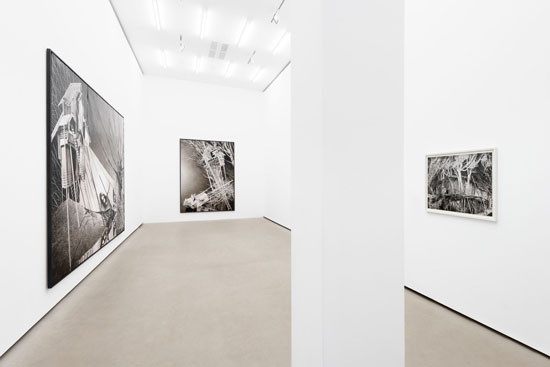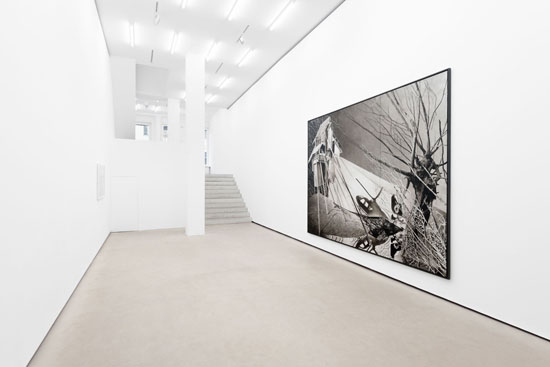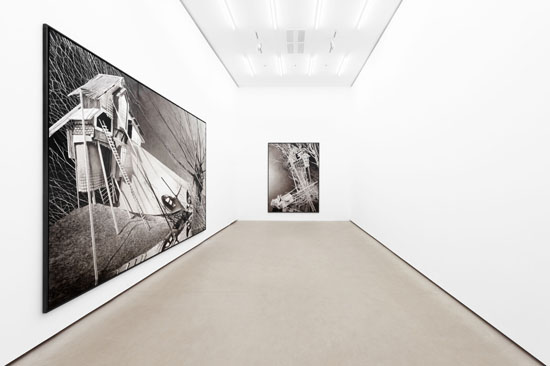Exhibitions
Archive

Mirjam Völker
28 January 2014 - 1 February 2014
Opening: Tuesday 28 January 2014, 5 to 9 pm
Mirjam Völker’s works show forms of dwelling – cottages, mobile homes, vehicle cabs, and tree houses. Dwellings can be refuges, havens, and retreat spaces. Optimally, they are sites of security and provide the defenseless with shelter from weather and external attacks. The meager, weathered, and deteriorating dwellings in Mirjam Völker’s works seem entirely inadequate to this purpose. They are placed like foreign objects in the middle of nature; empty and abandoned, they are overgrown by thickets. Destroyed and not at all homey, these shelters offer signs of discontent and fragility, rather than security and warmth.
In her works, built spatial constructions and untamed natural space stand in a relationship characterized by demarcation and interpenetration. The interventions are mutual: urbanity invades uncultivated terrain and burgeoning vegetation gradually reconquers space.

Though no person can be seen in Völker’s pictures, what were once refuges bear traces of former or current inhabitants, for example when a light shines through the drawn curtains of a mobile home. But what takes place behind them is withheld from the viewer’s gaze. The presence of something concealed is palpable, but remains a mere discomforting suspicion.
In her new, large-format works on paper, provisional wooden huts stand without solid ground on rickety stilts in a network of branches. Accessible only via long, narrow ladders, their great distance from the ground promises protection from natural threats and intruders, but at the same time the long stilts signal a dire fate. On the heaped ground or dry boughs that serve as their foundation, they cannot guarantee a stable stand; leaning only against desiccated trees, they end up in a hazardous tilt until they fall.
But whom do they bring to a fall, for whom were they built? Their mode of construction seems provisional: cobbled together from wood, corrugated metal, tarpaulins, and civilizational trash, they can hardly hold up to the vagaries of nature. Their raised position makes these huts observation posts. There are no doors, but behind slits, hatches, and barred windows one suspects eyes watching the surroundings.
While the work “zu Fall” (bringing down) tips over backward into the emptiness of dark waters and becomes entangled in the slope of their banks; in “Bruchstelle” (breaking point), a helicopter has crashed. The glare of floodlights suggests the scene of a crime, a rescue attempt, or a surveillance measure. Without clearing up what is happening, the powerful sources of light expose the nocturnal scenery. The crash is additionally concealed by a stretched piece of cloth on which the drama is vaguely shown. The viewer is not among the well-informed, but only an indirect witness of the events; the secret remains.
Mirjam Völker (born in 1977 in Wiesbaden) studied at the Akademie für Bildende Künste (Academy for Visual Arts), Johannes-Gutenberg Universität Mainz and at the Hochschule für Grafik und Buchkunst (Academy of Visual Arts) in Leipzig. She was a master student of Neo Rauch’s from 2008 to 2010. She lives and works in Leipzig.
TAKE FIVE
5 Weeks, 5 Artists, 5 Exhibitions
Galerie EIGEN + ART Berlin
With TAKE FIVE, the Galerie EIGEN + ART Berlin will show five exhibitions of five young artists for five weeks beginning on 14 January 2014.
The exhibitions will open weekly from Tuesday from 5 to 9 pm and be shown through Saturday. Each of the five artists has developed new works for the showing. With works that range from sculpture through painting and drawing to room installations, the gallery will thereby become the stage for a diverse exhibition program for a period of five weeks: Melora Kuhn and Lada Nakonechna have already been seen with exhibitions in the EIGEN+ART Lab; Mirjam Völker, Kristina Schuldt, and Kai Schiemenz were represented in group exhibitions in the Berlin and Leipzig galleries.
Kai Schiemenz
14 January 2014 - 18 2014
Opening: Tuesday, 14 January 2014, 5-9 p.m.
Kai Schiemenz (*1966 in Erfurt, lives and works in Berlin) focuses in his works on the city, space, and architecture and on the regulating function that these constructs carry out on people. His small-format sculptures are self-enclosed structures that combine digital techniques with natural materials like wood or paper. At the same time, they serve as models for spatially expansive installations and architectures for interiors and exteriors, in which Schiemenz uses lines of sight to construct spaces whose permeability enables them to involve the viewer directly. At the center is always the question of the influence of the built surroundings and the urban landscape on people. In his solo exhibition, Schiemenz shows two new groups of works in which the concept of architecture increasingly dissolves and the artificial materiality of the surfaces takes the foreground.
Melora Kuhn
21 January 2014 - 25 January 2014
Opening: Tuesday, 21 January 2014, 5-9 p.m.
The works of Melora Kuhn (*1971 in Boston, lives and works in New York) are a constant observation of people's experiences with themselves and with society. Kuhn makes use of the pictorial language of mythologies and history, in particular the pictorial forms of 19th-century American art history, from which she isolates individual pictures and places them in a new context. Her interest thereby is in details that are forgotten or elided in the narrative, in order to take a firmly established and well-known story in another direction and to inscribe a new readability into the personal biographies of the protagonists in her pictures. To do this, she uses the background to hint at the persons' state of mind or a contour drawing above the portrait to add a second narration. She will show new paintings in her exhibition.
See the work of Melora Kuhn
Lada Nakonechna
11 February 2014 - 15 February 2014
Opening: Tuesday 11 February 2014, 5 to 9 pm
Lada Nakonechna (*1981 in Dnipropetrovsk, Ukraine, lives and works in Kiev) confronts the viewer in her drawings, installations, videos, and performances with pictures of current events and pictorial experiences from the collective memory, which she manipulates or distorts. She often lets the human being, in the form of the viewer, become a manipulative, disruptive factor who himself influences and changes a given picture. For her exhibition, Nakonechna places a tower in the middle of the gallery room; like a lighthouse, it casts a cone of light onto the surrounding walls. When trying to decipher the texts written on the walls, the viewer constantly blocks the light he needs, or is blinded and caught, and must move with the light to be able to grasp everything. The lighthouse is actually a symbol for a firm hold, a glimmer of hope on the horizon, toward which one orients oneself when one has lost one's way. But where can it lead when four high walls lock the light up in an empty room?
See the work of Lada Nakonechna
Kristina Schuldt
18 February 2014 – 22 February 2014
Opening: Tuesday 18 February 2014, 5 to 9 pm
In the pictures of Kristina Schuldt (*1982 in Moscow, lives and works in Leipzig), faceless women's bodies lie, fall, loll languorously, or bend themselves, as two-dimensional tubes. They thereby resemble smoothly polished machines more than living beings. Kristina Schuldt unashamedly makes use of the pictorial forms of Classic Modernism, but she creates her own new pictorial language, for example from the wavy hair of a Fernand Léger painting and powerful, schematized bodies that recall the avant-garde pictures of the 1920s. She exposes her figures to a garish party illumination and uses cigarettes and miniskirts to give them a nonchalance and coolness that is more reminiscent of teenagers than of mature, strong women. While in her earlier pictures the figures and their limbs were subjected and "bored into" their situation, in the new works in the exhibition, an increasing consciousness of morals comes into play and is reflected in the bodies.